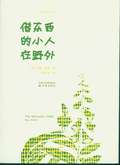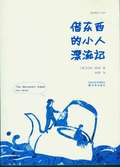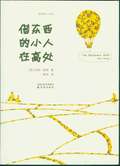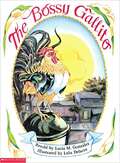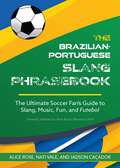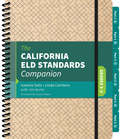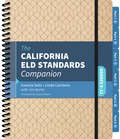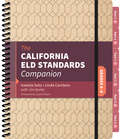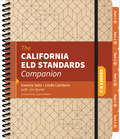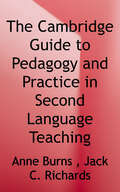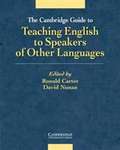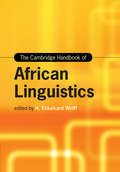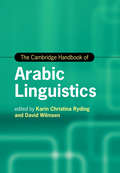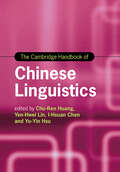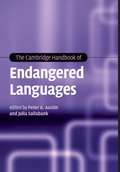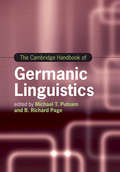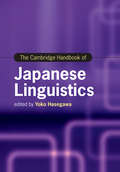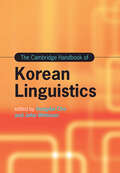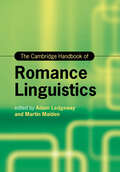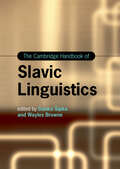- Table View
- List View
The Borrowers Afield (Mandarin Edition)
by Mary NortonPod, Homily, and Arrietty Clock's huge adventures have been thrilling children young and old for fifty years--and their appeal is as strong as ever in these handsome new paperback packages. While the original beloved interior illustrations by Beth and Joe Krush have been retained, Marla Frazee's striking cover illustrations capture these little people with a larger-than-life appeal.波德一家在人类的大搜捕中逃离了地板下的家 开始了颠沛流离的野外生活 他们打算去投奔住在獾洞里的亨德瑞利舅舅一家 但到那里时 亲戚们已不知去向 他们捡到一只破靴子 把它拖到河岸的洞里搭建了一个临时的家 阿瑞埃蒂结识了从吉卜赛人那里借东西的男孩斯皮勒 斯皮勒时常用自己的打猎收获接济这些初到野外的同类 冬天来了 住在靴子里的波德一家弹尽粮绝 喝光最后一点酒后沉沉睡去 醒来发现到了一辆吉卜赛人的大车上 这是怎么回事呢 他们能从吉卜赛人那里逃脱吗 斯皮勒又是怎么帮他们和亨德瑞利舅舅一家团聚的呢 雪貂男孩汤姆是他们的福星还是杀手
The Borrowers Afloat (Mandarin Edition)
by Mary NortonPod, Homily, and Arrietty Clock's huge adventures have been thrilling children young and old for fifty years--and their appeal is as strong as ever in these handsome new paperback packages. While the original beloved interior illustrations by Beth and Joe Krush have been retained, Marla Frazee's striking cover illustrations capture these little people with a larger-than-life appeal.波德一家在斯皮勒的带领下成功脱险 来到小男孩汤姆的住处 与生活在墙里的亨德瑞利舅舅一家会合 但不久 汤姆和爷爷就离开了这里 没有人迹的地方不可能支持两家小人的生活 所以波德不得不又带领家人走上流浪之旅 寻找新的家园 他们从地下管道出走 来到小河边的水壶中安顿下来 但一场突来的大雨将水壶冲到了河水中 小人开始了一场水上漂流冒险 他们最终能找到新家吗
The Borrowers Aloft (Mandarin Edition)
by Mary NortonPod, Homily, and Arrietty Clock's huge adventures have been thrilling children young and old for fifty years--and their appeal is as strong as ever in these handsome new paperback packages. While the original beloved interior illustrations by Beth and Joe Krush have been retained, Marla Frazee's striking cover illustrations capture these little people with a larger-than-life appeal.退休的老珀特先生童心灿烂 闲来无事在家里建起了一个微型村庄 波德一家人迁居来到这里 过起了安逸生活 好心的孟奇思小姐看到了他们 并和阿瑞埃蒂成为好朋友 时常暗中帮助他们 但好景不长 一天 他们被一对贪婪的夫妇抓到自己家的阁楼上 准备到春天就把他们关到玻璃笼子里招徕游客 波德一家人再次陷入绝境 他们在阁楼上度过了漫长的被囚禁的冬天 终于在春天到来前想到了逃走的办法 他们学着报纸上人类制作热气球的技术 制作了一个逃生的气球 再次回到了野外
The Borrowers Avenged (Mandarin Edition)
by Mary NortonPod, Homily, and Arrietty Clock's huge adventures have been thrilling children young and old for fifty years--and their appeal is as strong as ever in these handsome new paperback packages. While the original beloved interior illustrations by Beth and Joe Krush have been retained, Marla Frazee's striking cover illustrations capture these little people with a larger-than-life appeal.波德一家逃离了阁楼里的囚禁生活 回到了模型村庄里的家 因为害怕普拉特夫妇再度前来 他们在斯皮勒的带领下搬迁到了教区长住宅 并遇到了一直居住在那里的博学多才的小人皮尔格林 在大家的帮助下 他们重新找到了适合居住的家园 和亨德瑞利舅舅一家比邻而居 普拉特夫妇心有不甘地继续到处搜寻小人的下落 复活节快到了 阿瑞埃蒂吃惊地发现普拉特夫妇来到了教堂 小人能逃过他们的追捕吗 那贪婪残酷的一对是如何受到惩罚的呢
The Bossy Gallito / El gallo de bodas
by Lucia M. GonzalezÉrase una vez un gallito mandón que iba muy limpiecito a la boda de su tío Perico... Hasta que se ensució y quiso que todos lo ayudarán a volver a estar limpiecito. Un libro muy divertido en inglés y español que deleitará tanto a grandes como a chicos.
The Brazilian-Portuguese Slang Phrasebook: The Ultimate Soccer Fan's Guide to Slang, Music, Fun and Futebol
by Alice Rose Nati Vale Jadson CaçadorLearn to speak like a local before you hit the streets of Sao Paulo or beaches of Rio de Janeiro with this pocket-sized Brazilian Portuguese-English phrasebook.With this book in hand you can get off the sideline and join the local Brazilians as they party from the pitch to the beach. Chock-full of up-to-date slang phrases, after-hours expressions and insider information on futebol, this book will have you cheering, dancing, drinking and celebrating with the die-hard fans of the beautiful game. What&’s up, man? Iaí, cara? Can I join your pickup game? Posso bater uma pelada com vocês? Where is a cool bar to watch the game? Onde tem um barzinho legal pra assitir o jogo? Next round&’s on me. A proxima rodada é minha. We&’re all going to an underground dance club, wanna join? A gente vai pra um baile funk, tá afim? That girl in the VIP section is super hot. Aquela mina no camarote é muito gostosa. Let&’s sleep off our hangovers at the beach. Vamos curar a ressaca na praia.
The California ELD Standards Companion, Grades 3-5: Grades 3-5
by Ivannia Soto Linda J. Carstens James R. BurkeFor California teachers only! Here at last is that single teaching resource for making the critical link between the ELD Standards and the CCSS ELA Standards. Standard by standard, you’ll quickly discover how to integrate language development into your day-to-day content instruction, fully armed with an insider’s understanding of how best to support our many ELs. Horizontal and vertical views reveal how each ELD Standard changes and progresses by grade and proficiency level. What the Student Does sections unpack what meeting a standard looks like in practice. CCSS ELA Standards are displayed side by side with California’s ELD Standards so you can appreciate the purposeful alignment. What the Teacher Does sections provide specific instructional guidance.
The California ELD Standards Companion, Grades 3-5: Grades 3-5
by Ivannia Soto Linda J. Carstens James R. BurkeFor California teachers only! Here at last is that single teaching resource for making the critical link between the ELD Standards and the CCSS ELA Standards. Standard by standard, you’ll quickly discover how to integrate language development into your day-to-day content instruction, fully armed with an insider’s understanding of how best to support our many ELs. Horizontal and vertical views reveal how each ELD Standard changes and progresses by grade and proficiency level. What the Student Does sections unpack what meeting a standard looks like in practice. CCSS ELA Standards are displayed side by side with California’s ELD Standards so you can appreciate the purposeful alignment. What the Teacher Does sections provide specific instructional guidance.
The California ELD Standards Companion, Grades 9-12: Grades K-2
by Ivannia Soto Linda J. Carstens James R. Burke“This is an era of extraordinary promise and support for addressing the needs of California’s English learners. That’s why this book, The California ELD Standards Companion, is so important. It’s exactly the kind of bridge teachers need between standards and what it looks like in the classroom.” —LAURIE OLSEN, Strategic Adviser, The Sobrato Early Academic Language (SEAL) Initiative California teachers: you’re going to love this! Here at last is that single teaching resource for making the critical link between our ELD Standards and the CCSS ELA Standards. Standard by standard, you’ll quickly discover how to integrate language development into your day-to-day content instruction, armed with an insider’s understanding of how best to support our many English learners. Modeled after Jim Burke’s Common Core series, this Grades 9-12 volume of The California ELD Standards Companion is every bit “that version of the standards you wish you had” because it’s just so easy to digest and apply. It’s all here: Horizontal and vertical views reveal how each ELD Standard changes and progresses grade by grade and proficiency level by proficiency level. What the Student Does Sections, also scannable by grade and proficiency level, unpack in student-friendly language what meeting a standard looks like in practice. CCSS ELA Standards are displayed side by side with California’s ELD Standards so you can appreciate the purposeful alignment between the two as the basis for remodeling instructional practice. What the Teacher Does Sections provide specific instructional guidance by grade band, including student prompts and tips for differentiation across proficiency level. A dedicated vocabulary section offers a quick-reference glossary of key words and phrases as they are used within each ELD Standard. Each section concludes with a vignette from the California ELA/ELD Framework to illustrate exemplary standards-based instruction. Thanks to the ELD Standards, we are now free to teach our ELs the way we knew best all along: language and content taught hand in hand across the school day. Lean on Ivannia Soto and Linda Carstens’ California ELD Standards Companion as your one-stop guide for delivering that excellent education our ELs so deeply deserve.
The California ELD Standards Companion, Grades 9-12: Grades K-2
by Ivannia Soto Linda J. Carstens James R. Burke“This is an era of extraordinary promise and support for addressing the needs of California’s English learners. That’s why this book, The California ELD Standards Companion, is so important. It’s exactly the kind of bridge teachers need between standards and what it looks like in the classroom.” —LAURIE OLSEN, Strategic Adviser, The Sobrato Early Academic Language (SEAL) Initiative California teachers: you’re going to love this! Here at last is that single teaching resource for making the critical link between our ELD Standards and the CCSS ELA Standards. Standard by standard, you’ll quickly discover how to integrate language development into your day-to-day content instruction, armed with an insider’s understanding of how best to support our many English learners. Modeled after Jim Burke’s Common Core series, this Grades 9-12 volume of The California ELD Standards Companion is every bit “that version of the standards you wish you had” because it’s just so easy to digest and apply. It’s all here: Horizontal and vertical views reveal how each ELD Standard changes and progresses grade by grade and proficiency level by proficiency level. What the Student Does Sections, also scannable by grade and proficiency level, unpack in student-friendly language what meeting a standard looks like in practice. CCSS ELA Standards are displayed side by side with California’s ELD Standards so you can appreciate the purposeful alignment between the two as the basis for remodeling instructional practice. What the Teacher Does Sections provide specific instructional guidance by grade band, including student prompts and tips for differentiation across proficiency level. A dedicated vocabulary section offers a quick-reference glossary of key words and phrases as they are used within each ELD Standard. Each section concludes with a vignette from the California ELA/ELD Framework to illustrate exemplary standards-based instruction. Thanks to the ELD Standards, we are now free to teach our ELs the way we knew best all along: language and content taught hand in hand across the school day. Lean on Ivannia Soto and Linda Carstens’ California ELD Standards Companion as your one-stop guide for delivering that excellent education our ELs so deeply deserve.
The California ELD Standards Companion: Grades 6-8
by Jim Burke Ivannia Soto Linda CarstensCalifornia teachers: you’re going to love this! Here at last is that single teaching resource for making the critical link between our ELD Standards and the CCSS ELA Standards. Standard by standard, you’ll quickly discover how to integrate language development into your day-to-day content instruction, armed with an insider’s understanding of how best to support our many English learners. Modeled after Jim Burke’s Common Core series, this Grades 6-8 volume of The California ELD Standards Companion is every bit “that version of the standards you wish you had” because it’s just so easy to digest and apply. It’s all here: Horizontal and vertical views reveal how each ELD Standard changes and progresses grade by grade and proficiency level by proficiency level. What the Student Does Sections, also scannable by grade and proficiency level, unpack in student-friendly language what meeting a standard looks like in practice. CCSS ELA Standards are displayed side by side with California’s ELD Standards so you can appreciate the purposeful alignment between the two as the basis for remodeling instructional practice. What the Teacher Does Sections provide specific instructional guidance by grade band, including student prompts and tips for differentiation across proficiency level. A dedicated vocabulary section offers a quick-reference glossary of key words and phrases as they are used within each ELD Standard. Each section concludes with a vignette from the California ELA/ELD Framework to illustrate exemplary standards-based instruction. Thanks to the ELD Standards, we are now free to teach our ELs the way we knew best all along: language and content taught hand in hand across the school day. Lean on Ivannia Soto and Linda Carstens’ California ELD Standards Companion as your one-stop guide for delivering that excellent education our ELs so deeply deserve.
The California ELD Standards Companion: Grades 6-8
by Jim Burke Ivannia Soto Linda CarstensCalifornia teachers: you’re going to love this! Here at last is that single teaching resource for making the critical link between our ELD Standards and the CCSS ELA Standards. Standard by standard, you’ll quickly discover how to integrate language development into your day-to-day content instruction, armed with an insider’s understanding of how best to support our many English learners. Modeled after Jim Burke’s Common Core series, this Grades 6-8 volume of The California ELD Standards Companion is every bit “that version of the standards you wish you had” because it’s just so easy to digest and apply. It’s all here: Horizontal and vertical views reveal how each ELD Standard changes and progresses grade by grade and proficiency level by proficiency level. What the Student Does Sections, also scannable by grade and proficiency level, unpack in student-friendly language what meeting a standard looks like in practice. CCSS ELA Standards are displayed side by side with California’s ELD Standards so you can appreciate the purposeful alignment between the two as the basis for remodeling instructional practice. What the Teacher Does Sections provide specific instructional guidance by grade band, including student prompts and tips for differentiation across proficiency level. A dedicated vocabulary section offers a quick-reference glossary of key words and phrases as they are used within each ELD Standard. Each section concludes with a vignette from the California ELA/ELD Framework to illustrate exemplary standards-based instruction. Thanks to the ELD Standards, we are now free to teach our ELs the way we knew best all along: language and content taught hand in hand across the school day. Lean on Ivannia Soto and Linda Carstens’ California ELD Standards Companion as your one-stop guide for delivering that excellent education our ELs so deeply deserve.
The California ELD Standards Companion: Grades K-2
by Jim Burke Ivannia Soto Linda CarstensJust for California teachers! California teachers: you’re going to love this! Here at last is that single teaching resource for making the critical link between our ELD Standards and the CCSS ELA Standards. Standard by standard, you’ll quickly discover how to integrate language development into your day-to-day content instruction, armed with an insider’s understanding of how best to support our many English learners. Modeled after Jim Burke’s Common Core series, this Grades K-2 volume of The California ELD Standards Companion is every bit “that version of the standards you wish you had” because it’s just so easy to digest and apply. It’s all here: Horizontal and vertical views reveal how each ELD Standard changes and progresses grade by grade and proficiency level by proficiency level. What the Student Does Sections, also scannable by grade and proficiency level, unpack in student-friendly language what meeting a standard looks like in practice. CCSS ELA Standards are displayed side by side with California’s ELD Standards so you can appreciate the purposeful alignment between the two as the basis for remodeling instructional practice. What the Teacher Does Sections provide specific instructional guidance by grade band, including student prompts and tips for differentiation across proficiency level. A dedicated vocabulary section offers a quick-reference glossary of key words and phrases as they are used within each ELD Standard. Each section concludes with a vignette from the California ELA/ELD Framework to illustrate exemplary standards-based instruction. Thanks to the ELD Standards, we are now free to teach our ELs the way we knew best all along: language and content taught hand in hand across the school day. Lean on Ivannia Soto and Linda Carstens’ California ELD Standards Companion as your one-stop guide for delivering that excellent education our ELs so deeply deserve.
The California ELD Standards Companion: Grades K-2
by Jim Burke Ivannia Soto Linda CarstensJust for California teachers! California teachers: you’re going to love this! Here at last is that single teaching resource for making the critical link between our ELD Standards and the CCSS ELA Standards. Standard by standard, you’ll quickly discover how to integrate language development into your day-to-day content instruction, armed with an insider’s understanding of how best to support our many English learners. Modeled after Jim Burke’s Common Core series, this Grades K-2 volume of The California ELD Standards Companion is every bit “that version of the standards you wish you had” because it’s just so easy to digest and apply. It’s all here: Horizontal and vertical views reveal how each ELD Standard changes and progresses grade by grade and proficiency level by proficiency level. What the Student Does Sections, also scannable by grade and proficiency level, unpack in student-friendly language what meeting a standard looks like in practice. CCSS ELA Standards are displayed side by side with California’s ELD Standards so you can appreciate the purposeful alignment between the two as the basis for remodeling instructional practice. What the Teacher Does Sections provide specific instructional guidance by grade band, including student prompts and tips for differentiation across proficiency level. A dedicated vocabulary section offers a quick-reference glossary of key words and phrases as they are used within each ELD Standard. Each section concludes with a vignette from the California ELA/ELD Framework to illustrate exemplary standards-based instruction. Thanks to the ELD Standards, we are now free to teach our ELs the way we knew best all along: language and content taught hand in hand across the school day. Lean on Ivannia Soto and Linda Carstens’ California ELD Standards Companion as your one-stop guide for delivering that excellent education our ELs so deeply deserve.
The Cambridge Guide to Pedagogy and Practice in Second Language Teaching
by Jack C. Richards Anne BurnsThis collection of original articles provides a state-of-the-art overview of key issues and approaches in contemporary language teaching. <p><p>Written by internationally prominent researchers, educators, and emerging scholars, the chapters are grouped into five sections: rethinking our understanding of teaching, learner diversity and classroom learning, pedagogical approaches and practices, components of the curriculum, and media and materials. <p><p>Each chapter covers key topics in teaching methodology such as reflective pedagogy, teaching large classes, outcomes-based language learning, speaking instruction, and technology in the classroom. Chapters assume no particular background knowledge and are written in an accessible style.
The Cambridge Guide to Teaching English to Speakers of Other Languages
by Ronald CarterThis important book, with 32 chapters by leading figures in the field, is an up-to-date guide to the central areas of applied linguistics and language studies with particular reference to TESOL. It looks at the current state of TESOL as well as at what is likely to happen in the future.
The Cambridge Handbook of African Linguistics (Cambridge Handbooks in Language and Linguistics)
by H. Ekkehard WolffThis book provides an in-depth and comprehensive state-of-the-art study of 'African languages' and 'language in Africa' since its beginnings as a 'colonial science' at the turn of the twentieth century in Europe. Compiled by 56 internationally renowned scholars, this ground breaking study looks at past and current research on 'African languages' and 'language in Africa' under the impact of paradigmatic changes from 'colonial' to 'postcolonial' perspectives. It addresses current trends in the study of the role and functions of language, African and other, in pre- and postcolonial African societies. Highlighting the central role that the 'language factor' plays in postcolonial transformation processes of sociocultural modernization and economic development, it also addresses more recent, particularly urban, patterns of communication, and outlines applied dimensions of digitalization and human language technology.
The Cambridge Handbook of Arabic Linguistics (Cambridge Handbooks in Language and Linguistics)
by Karin Christina Ryding David WilmsenArabic linguistics encompasses a range of language forms and functions from formal to informal, classical to contemporary, written to spoken, all of which have vastly different research traditions. Recently however, the increasing prominence of new methodologies such as corpus linguistics and sociolinguistics have allowed Arabic linguistics to be studied from multiple perspectives, revealing key discoveries about the nature of Arabic-in-use and deeper knowledge of traditional fields of study. With contributions from internationally renowned experts on the language, this handbook provides a state-of-the-art overview of both traditional and modern topics in Arabic linguistics. Chapters are divided into six thematic areas: applied Arabic linguistics, variation and sociolinguistics, theoretical studies, computational and corpus linguistics, new media studies and Arabic linguistics in literature and translation. It is an essential resource for students and researchers wishing to explore the exciting and rapidly moving field of Arabic linguistics.
The Cambridge Handbook of Chinese Linguistics (Cambridge Handbooks in Language and Linguistics)
by Yu-Yin HsuThe linguistic study of Chinese, with its rich morphological, syntactic and prosodic/tonal structures, its complex writing system, and its diverse socio-historical background, is already a long-established and vast research area. With contributions from internationally renowned experts in the field, this Handbook provides a state-of-the-art survey of the central issues in Chinese linguistics. Chapters are divided into four thematic areas: writing systems and the neuro-cognitive processing of Chinese, morpho-lexical structures, phonetic and phonological characteristics, and issues in syntax, semantics, pragmatics, and discourse. By following a context-driven approach, it shows how theoretical issues in Chinese linguistics can be resolved with empirical evidence and argumentation, and provides a range of different perspectives. Its dialectical design sets a state-of-the-art benchmark for research in a wide range of interdisciplinary and cross-lingual studies involving the Chinese language. It is an essential resource for students and researchers wishing to explore the fascinating field of Chinese linguistics.
The Cambridge Handbook of Endangered Languages
by Peter K. Austin Julia SallabankIt is generally agreed that about 7,000 languages are spoken across the world today and at least half may no longer be spoken by the end of this century. This state-of-the-art Handbook examines the reasons behind this dramatic loss of linguistic diversity, why it matters, and what can be done to document and support endangered languages. The volume is relevant not only to researchers in language endangerment, language shift and language death, but to anyone interested in the languages and cultures of the world. It is accessible both to specialists and non-specialists: researchers will find cutting-edge contributions from acknowledged experts in their fields, while students, activists and other interested readers will find a wealth of readable yet thorough and up-to-date information.
The Cambridge Handbook of Germanic Linguistics (Cambridge Handbooks in Language and Linguistics)
by Michael T. Putnam B. Richard PageThe Germanic language family ranges from national languages with standardized varieties, including German, Dutch and Danish, to minority languages with relatively few speakers, such as Frisian, Yiddish and Pennsylvania German. Written by internationally renowned experts of Germanic linguistics, this Handbook provides a detailed overview and analysis of the structure of modern Germanic languages and dialects. Organized thematically, it addresses key topics in the phonology, morphology, syntax, and semantics of standard and nonstandard varieties of Germanic languages from a comparative perspective. It also includes chapters on second language acquisition, heritage and minority languages, pidgins, and urban vernaculars. The first comprehensive survey of this vast topic, the Handbook is a vital resource for students and researchers investigating the Germanic family of languages and dialects.
The Cambridge Handbook of Japanese Linguistics (Cambridge Handbooks In Language And Linguistics)
by Yoko Hasegawa<P>The linguistic study of Japanese, with its rich syntactic and phonological structure, complex writing system, and diverse sociohistorical context, is a rapidly growing research area. This book, designed to serve as a concise reference for researchers interested in the Japanese language and in typological studies of language in general, explores diverse characteristics of Japanese that are particularly intriguing when compared with English and other European languages. It pays equal attention to the theoretical aspects and empirical phenomena from theory-neutral perspectives, and presents necessary theoretical terms in clear and easy language. <P>It consists of five thematic parts including sound system and lexicon, grammatical foundation and constructions, and pragmatics/sociolinguistics topics, with chapters that survey critical discussions arising in Japanese linguistics. The Cambridge Handbook of Japanese Linguistics will be welcomed by general linguists, and students and scholars working in linguistic typology, Japanese language, Japanese linguistics and Asian Studies.
The Cambridge Handbook of Korean Linguistics (Cambridge Handbooks in Language and Linguistics)
by John Whitman Sungdai ChoThe 'Korean wave' in music and film and Korea's rise to become the twelfth economic power in the world have boosted the world-wide popularity of Korean language study. The linguistic study of Korean, with its rich syntactic and phonological structure, complex writing system, and unique socio-historical context, is now a rapidly growing research area. Contributions from internationally renowned experts on the language provide a state-of-the-art overview of key current research in Korean language and linguistics. Chapters are divided into five thematic areas: phonetics and phonology, morphology and syntax, semantics and pragmatics, sociolinguistics and psycholinguistics, and language pedagogy. The Handbook includes cross-linguistic data to illuminate the features of Korean, and examples in Korean script, making it suitable for advanced students and researchers with or without prior knowledge of Korean linguistics. It is an essential resource for students and researchers wishing to explore the exciting and rapidly moving field of Korean linguistics.
The Cambridge Handbook of Romance Linguistics (Cambridge Handbooks in Language and Linguistics)
by Adam Ledgeway Martin MaidenThe Romance languages and dialects constitute a treasure trove of linguistic data of profound interest and significance. Data from the Romance languages have contributed extensively to our current empirical and theoretical understanding of phonetics, phonology, morphology, syntax, semantics, pragmatics, sociolinguistics, and historical linguistics. Written by a team of world-renowned scholars, this Handbook explores what we can learn about linguistics from the study of Romance languages, and how the body of comparative and historical data taken from them can be applied to linguistic study. It also offers insights into the diatopic and diachronic variation exhibited by the Romance family of languages, of a kind unparalleled for any other Western languages. By asking what Romance languages can do for linguistics, this Handbook is essential reading for all linguists interested in the insights that a knowledge of the Romance evidence can provide for general issues in linguistic theory.
The Cambridge Handbook of Slavic Linguistics (Cambridge Handbooks in Language and Linguistics)
by Danko Šipka Wayles BrowneThe linguistic study of the Slavic language family, with its rich syntactic and phonological structures, complex writing systems, and diverse socio-historical context, is a rapidly growing research area. Bringing together contributions from an international team of authors, this Handbook provides a systematic review of cutting-edge research in Slavic linguistics. It covers phonetics and phonology, morphology and syntax, lexicology, and sociolinguistics, and presents multiple theoretical perspectives, including synchronic and diachronic. Each chapter addresses a particular linguistic feature pertinent to Slavic languages, and covers the development of the feature from Proto-Slavic to present-day Slavic languages, the main findings in historical and ongoing research devoted to the feature, and a summary of the current state of the art in the field and what the directions of future research will be. Comprehensive yet accessible, it is essential reading for academic researchers and students in theoretical linguistics, linguistic typology, sociolinguistics and Slavic/East European Studies.
